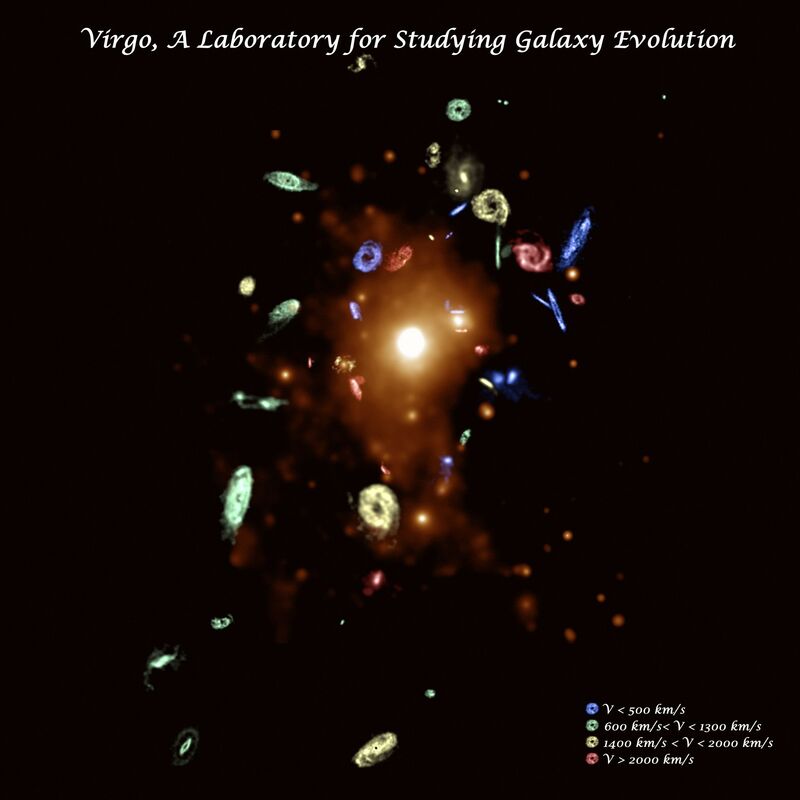Virgo, A Laboratory for Studying Galaxy Evolution
Description
Galaxies evolve over time, some lose gas, some accrete, some merge and some just run out of gas. The environment may affect the evolution of galaxies. In this picture we show what the cluster environment might do to the gas in galaxies. The image (20x20 deg^2 centered at RA=12h32m0.0s, Dec=10d30'0.0'') shows the neutral hydrogen gas (HI, 21cm) distribution of 47 spiral galaxies in the Virgo cluster on the X-ray hot gas background (ROSAT, Bohringer et al. 1994). The HI data were taken with the Very Large Array (VLA). The galaxies are located at their proper position in the cluster but their size has been increased by a factor of 10. Note that the gas disks are very small near the cluster center where the hot gas is densest. They are much smaller than the optical size of the galaxies. Far away from the center the gas extends much beyond the optical size. This suggests that in the center, galaxies get stripped of their gas by the hot dense intralcluster medium. Quite surprisingly however we also find some very small HI disks far away from the cluster center. Perhaps these galaxies already passed through the center and are now on their way out. Many galaxies close to the edge of the X-ray gas show extended tails of HI, mostly pointing away from the cluster center. Do the galaxies get stretched out by the potential as they fall into the cluster? The colors indicate the relative velocity of the galaxies with respect to the cluster mean velocity (~1200 km/s). These spiral galaxies appear to be clustered in velocity, as if they are falling in as groups. Virgo, not only due to its proximity but also as a still actively forming galaxy cluster, offers an ideal laboratory for studying details of how the cluster environment affects the evolution of galaxies.
In this work, the HI data from our recently completed Cs-array survey of the selected Virgo spiral galaxies have been combined (AK563, AK553, AK514). Among 47 galaxies appearing in this figure, 31 galaxies were observed for one of the three aforementioned projects. The integration time on each source is ~8 hours with the typical beam size of ~16"x16". This corresponds to the HI column density sensitivity of as deep as ~3.5x10^19 cm^-2 in 3-sigma. We also combined 16 Virgo galaxies from the NRAO archive which are comparible with ours in quality.
Creator
Legacy Astronomical Images
Rights
NRAO/AUI/NSF does not hold full copyright for this image. Contact the archivist for details.
Type
Legacy Astronomical Image
Object Name
Virgo Cluster
Photo Credit
Chung et al., Columbia University
Investigators
Aeree Chung, Hugh Crowl, Jeff Kenney, Jacqueline van Gorkom, Bernd Vollmer
Telescope
Very Large Array (VLA)
Observation Date
2005-08-06
Type of Observation
spectral line
Center of Image
RA 12:32:0.000, Dec: 10:30:0.000 (J2000)
Field of View
20.000000 x 20.000000 degrees
Notes
Contact the archivist for a high resolution tif of this image.
Series
Galaxies Series
Unit
Clusters Unit
Citation
Legacy Astronomical Images, “Virgo, A Laboratory for Studying Galaxy Evolution,” NRAO/AUI Archives, accessed June 13, 2025, https://www.nrao.edu/archives/items/show/33533.

